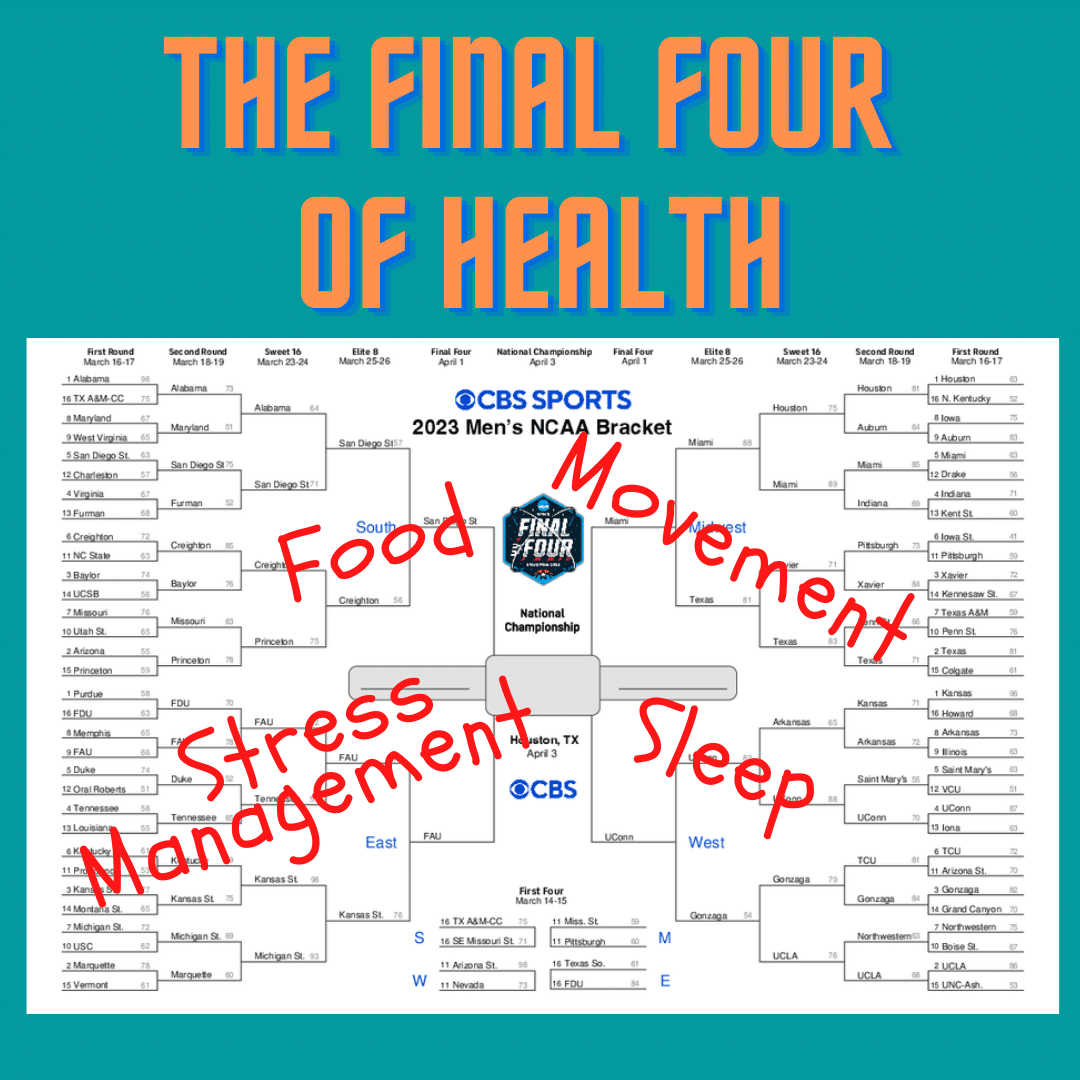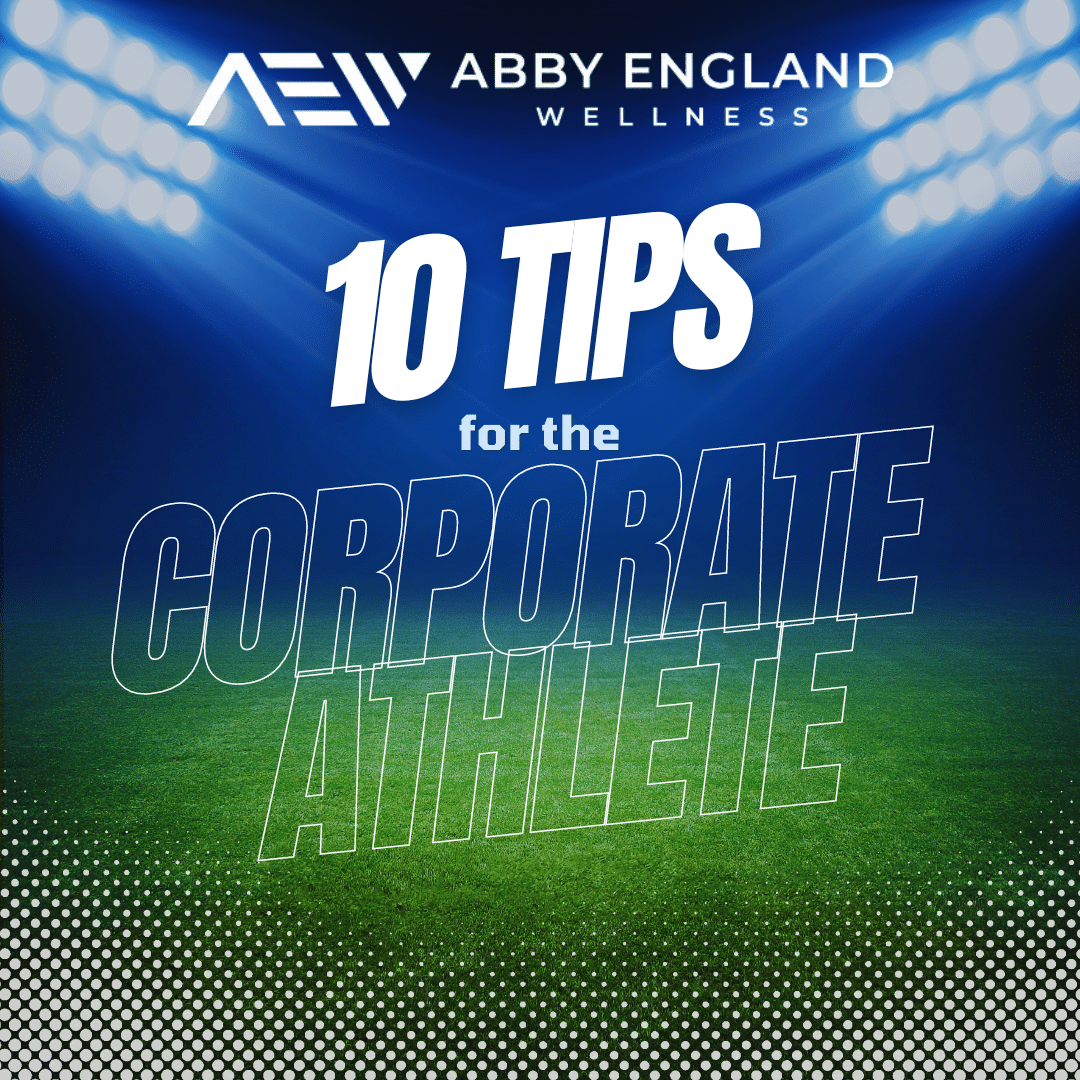With school back in session, kids and adults should be fueling their day with a…

Getting to The Big Dance with the Final Four of Health
We’re at the peak of March Madness and it has been narrowed down to the final four teams, so I thought it fitting to talk about the Final Four of Health: food, sleep, movement, and stress management. The “Healthy Final Four” work in harmony and when they’re prioritized, it’s an automatic bid for increased energy, weight loss, more confidence, less stress, and insurance for long term health. The research on these four areas is a slam dunk: click here to get my MVP recommendations of books, podcasts, and other resources.
While your initial reaction to the Final Four of Health may be similar to when the powerhouses usually make it to the finals (“duh, of course that team made it again”), based on my experience working with clients, many people don’t realize the interconnectivity of the Healthy Final Four until we discuss each one in detail and explore how they’re connected. Just as competition makes any team stronger, when one of the Healthy Final Four is strong, usually the others are as well.
In this article, I share the importance of the Healthy Final Four and how to bring more awareness and intentionality to them.
The first step is conducting the Scouting Report
The first step is assessing where you’re at today within each of the Final Four. The scouting report analyzes the competition so that you know what to typically expect from the other team. Similarly, you can analyze your typical behaviors as they relate to food, sleep, movement, and stress management. In my one-on-one work with clients, they rate each of the Final Four on a scale from 1 to 10, assessing where they’re currently at and talk about why they chose that number. There is no judgment, shame, or comparison. We’re simply learning your typical behaviors and establishing a baseline. It’s during this conversation that the correlation is made – when one domino falls, they all seem to fall. There is a correlative relationship among them: when one is prioritized, they’re usually all prioritized but when one slips, the others fall quickly behind. Let’s jump into each of the Final Four.
Sleep: Your Go To Guy
In terms of the NCAA bracket, sleep is the number one seed. It’s the underpinning that keeps all the others in check. When the team needs a last minute basket, pass the ball to your go to guy (Michael Jordan, the GOAT). When you need to reset and refresh, your go-to is sleep.
For most, the first domino is sleep. When sleep falls, the others fall as well. On the flip side, when sleep is prioritized, meaning a commitment to a pre-bedtime routine, you wake up mentally restored and physically refreshed. The science on sleep explains why it’s so important (cognitive function, weight regulation, biological processes) but you don’t need data and facts, you can feel it. Comparing the mornings from a good night’s sleep vs a night of crappy sleep (or not enough) is all the data one needs. A good night’s sleep will keep you away from getting into a scoring slump.
The tone of the morning usually sets the tone for the rest of the day. And a good morning starts with the night before. A night of sub-par sleep very easily results in too many cups of caffeine to help get you through the day; poor food choices because your brain is searching for sugar as a pick me up; problems seem amplified and your stress management techniques foul out.
Food: The Game Plan
Food is the number two seed. We make a decision what to put in our bodies two to three times per day, every day. Food is fuel and you make the choice whether it’s a three-pointer or an unnecessary turnover.
Transparently, most of my clients have a tug of war relationship with food. They love it but they don’t love the context that surrounds food such as meal planning, calorie tracking, internal debates over every meal, and external debates with family members based on their preferences! This tug of war can feel like the players on the team aren’t working together ultimately causing stress. For many clients, when they’re not getting enough sleep and stress is high, their food choices are heavily impacted. But when the X’s and O’s come together in a beautifully executed play, healthy food choices are automatic.
Movement: Bigger Isn’t Always Better
Movement is the number 8 seed, middle of the pack. You want to balance your movement like a good defense strategy: sometimes you exert the physical stamina for a full court press and sometimes you ease up and fall back into a zone defense.
While many of us think “more is better” in terms of movement, that’s not the case to maintain good health. Your movement should align with your fitness goals and for many of us simply getting in frequent bouts of movement throughout the day is immensely impactful.
For example, did you know standing burns twice as many calories as sitting? Standing for half the day can pay huge dividends. And you may have heard hitting 10,000 steps per day is important, but have you tracked it with a pedometer? Getting 10,000 steps a day is quite a lot and takes intentionality! Just like doing the fundamentals correctly leads to wins, cementing these small, basic habits consistently leads to a winning healthy lifestyle.
Unmanaged Stress: The Buzzer Beater
Stress Management is the number 16 seed that is scrappy, relentless, comes out of nowhere and sneaks up on you.
You can score baskets, hustle on defense, and have minimal turnovers for the entire game but if at the end your opponent hits a last second buzzer beater, you just lost. Unmanaged stress is the buzzer beater that means the difference between advancing or getting on the bus to go back home. The thing about stress is that you can be doing all the right things: prioritizing sleep, eating well, consistently moving, but if you don’t have a way to consistently manage your stress (ie downregulate your body into a relaxed state) then it sabotages all of your other efforts.
My clients usually realize there’s an opposite correlation between their stress level and their self-control and will power. When one is high, the other is low. It’s like the number one seed playing the number sixteen seed in the first round – it’s an unfair matchup. During periods of high stress, people tend to eat more, move less, and have less self-control. At the end of a long day, when you’re in overtime and facing decision fatigue, it’s easy to give into stress and partake in unhealthy behaviors that feel good in the moment.
If you can reduce stress or manage it better, it will help you establish consistency and you’ll be able to finish the game as strong as you started. The more you interweave stress management and enjoyment into your daily routine it becomes habit and stress becomes less stressful.
Becoming the National Champion of your Health
At the start of the season, every team has the same goal: to become the National Champion. Your next step is figuring out what your specific health goals are.
After assessing your typical behaviors with the scouting report, the next question is “What does being a National Champion of my health look like?” Asked differently and using our scale analogy, “What does a 10 look like?”
This question prompts exciting, creative thinking and is usually when my clients go on a scoring frenzy quickly shooting off all the behaviors and habits they want to be doing if they were living at a 10. And each person’s definition of a 10 is completely different because we all have unique likes, dislikes, experiences, and responsibilities. All of this uniqueness makes you, you. So my 10 looks different than your 10 which looks different from your teammate’s 10.
But what each of our respective health goals have in common is they’re achieved by prioritizing the Healthy Final Four. Regardless of their seed, the powerhouses of food, sleep, movement, and stress management beat out the competition and make it to the Final Four every year.
How 1:1 coaching helps you achieve your One Shining Moment
And all the years, no one knows
Just how hard you worked, but now it shows…
That One Shining Moment you reached deep inside
One Shining Moment, you knew you were alive
Mike Krzyzewski (Men’s coach at Duke) and Pat Summit (Women’s coach at Tennessee), two iconic collegiate coaches didn’t win multiple national championships by accident. It takes drills working on the fundamentals; daily practices to experiment with what works and what doesn’t; scrimmages to test out ideas; all to prepare for game day. The coach sets the tone: practice like you play.
Just like how Coach K and Pat can’t put on a jersey and play for the team, a Health & Wellness Coach can’t meal plan, exercise, sleep, or manage your stress for you. Only you can do that. But a coach can be your support, guide, encourager, and help you see your blind spots to assist you in achieving your big, audacious goals.
In my experience with clients, most people want to be living at their ideal level of a 10 but they want the behaviors and habits to be on autopilot. They don’t want every meal to be an internal debate, thus freeing up mental energy. They want to regain the vitality of their youth to exercise and do activities they enjoy. They want their 10 to be their new lifestyle and they don’t want to have to think about it, they just live this way with ease. But getting from point A to point B is the challenge. And that’s exactly what coaching with a National Board Certified Health & Wellness Coach can help you achieve. Getting from where you are today to where you’d like to be.
If you’re curious how adding a Health Coach to your wellness team may help you reach your goals, I offer free discovery calls for prospective clients.
If you’re interested in learning more about how these Final Four work in harmony towards your health goals, click here to get my MVP recommendations of books, podcasts, and other resources.


